
 Circumcision Styles
Circumcision Styles
Not all circumcisions are the same!
In this section of the CIRCLIST website you will find a wealth of information about the terminology used to describe styles of circumcision. Being able to communicate one’s expectations prior to the procedure is vital if disappointment is to be avoided, so be sure to establish a common terminology with your surgeon and discuss your style preferences before the circumcision takes place.
Definitions of Style Establishing a common terminology.
Anatomy and Circumcision Terminology
First, let’s revise our knowledge of anatomy. (There’s more detail in our
Anatomy chapter if you need it).
The diagram below is a longitudinal section through an uncircumcised penis. Note especially that the Inner Foreskin and Outer Foreskin are separate entities,
not the opposite sides of a single layer of tissue. They are not attached to each other and in consequence are mobile with respect to each other. Thus it is possible to remove unequal amounts of the two layers. Understanding this is crucial to an understanding of circumcision styles.
Figure 1 : Longitudinal section through an uncircumcised penis:
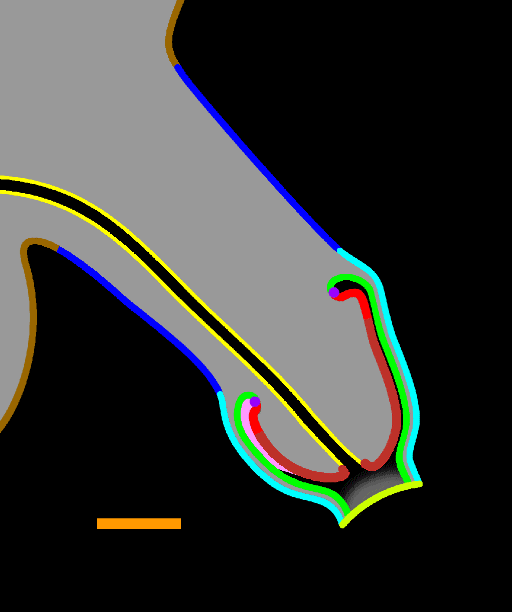 |
Colour Key:
Dull red: Glans of the penis
Bright red: Coronal rim of the glans
Violet: Sulcus
Pink: Frenulum
Green: Inner foreskin
Lime: Frenar band
Cyan: Outer foreskin
Blue: Shaft skin
Brown: Other skin
Yellow: Urethra
Grey: Various body tissue
And in Figure 2 below...
Orange: Tissue to be removed
|
Now let’s consider the first two of the "variables" relating to styles of circumcision - the high/low parameter and the loose/tight parameter.
The high/low parameter is a way of stating
what is removed. The loose/tight parameter is a way of stating
how much is removed. These variables are almost totally independent, hence there are four extremes:
- Low and Loose
- Low and Tight
- High and Loose
- High and Tight
and an infinite number of possibilities in-between.
The terms Loose and Tight are fairly self-explanatory, but a frequently-asked question is “What’s meant by 'High' and 'Low'? Where does the nomenclature come from?”
The answer is simple. Imagine two circumcised men of the same stature standing alongside each other, both flaccid. One has a circumcision style that retained inner foreskin (the 'high' style) whilst the other has a circumcision style that removed inner foreskin (the 'low' style). The circumcision scar line of the man with the high style will be part-way up his penis whereas the circumcision scar line of the man with the low style will be close to the rim of his glans. The scar line of the man with the high style will therefore be higher off the ground than the scar line of the man with the low style; that scar will be closer to the ground and therefore lower. Hence "high" and "low".
The four extremes are illustrated in the table below. Few circumcisions will actually resemble those illustrated in the "After" column; the drawings slightly exaggerate the situation in order to highlight the differences.
Figure 2 : Extremes of High/Low and Loose/Tight. What gets removed?
 |
BEFORE
Tissue to be removed in orange |
AFTER
Flaccid in each case |
COMMENTS |
Low and
Loose |
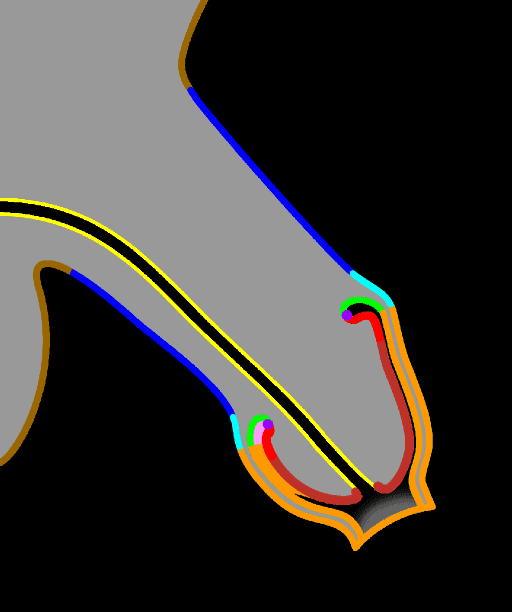 |
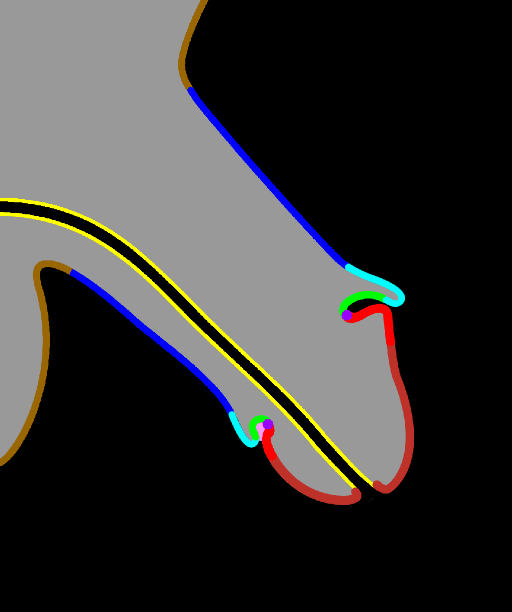 |
Almost all the inner foreskin has been removed along with an equal amount of outer foreskin. No tension has been placed in the shaft skin, with the result that the flaccid penis droops and the sulcus is not held fully open. |
Low and
Tight |
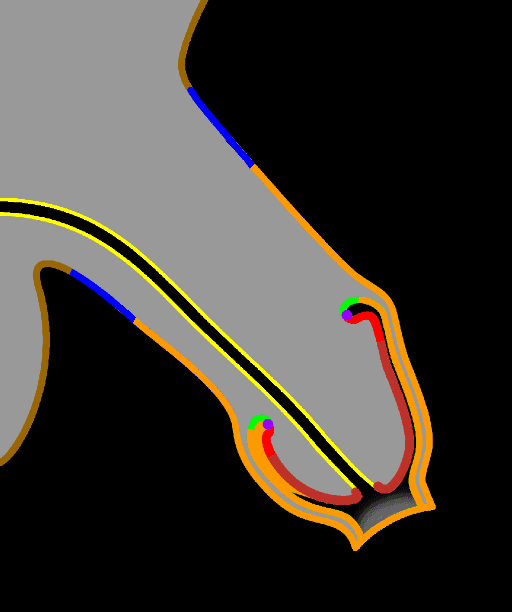 |
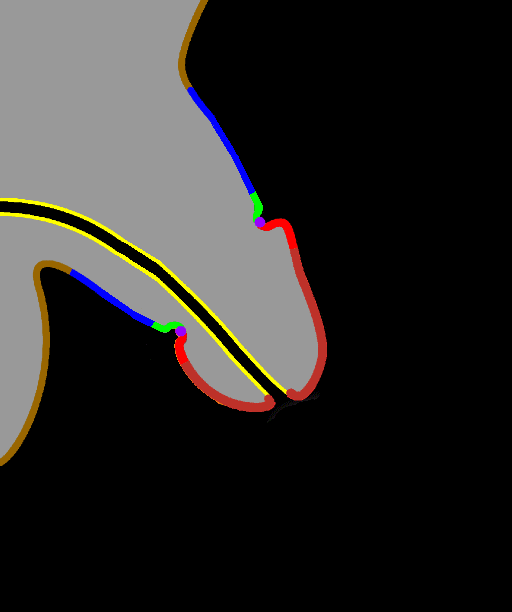 |
The maximum possible amount of inner foreskin has been removed along with the whole of the outer foreskin plus a considerable portion of shaft skin. This tightens the residual shaft skin so that the sulcus is held fully open. In extreme cases a child's penis could appear to be shortened but the skin will stretch to permit a full erection. |
High and
Loose |
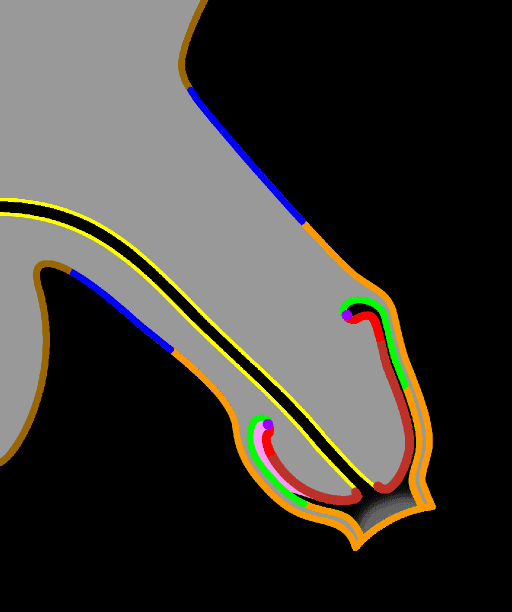 |
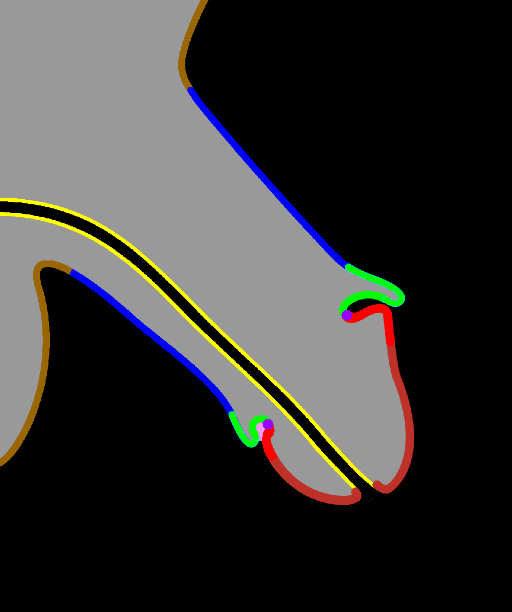 |
Much of the of inner foreskin has been retained, folded back on itself to face outwards and assume the role of shaft skin. The outer foreskin has been removed along with some shaft skin, but not enough to place the residue under tension. Thus some surplus skin will bunch up in the sulcus. |
High and
Tight |
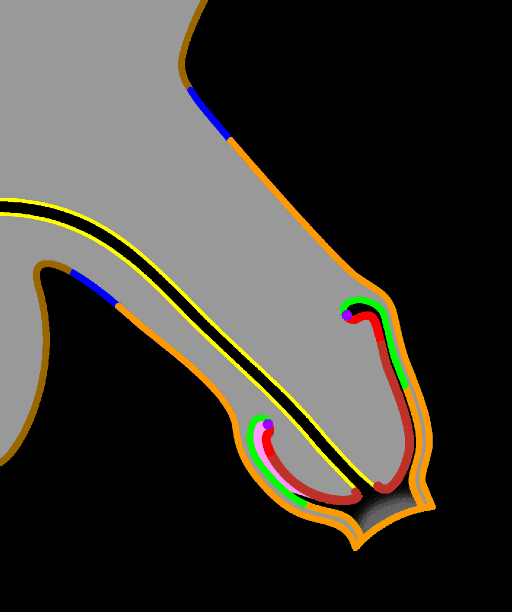 |
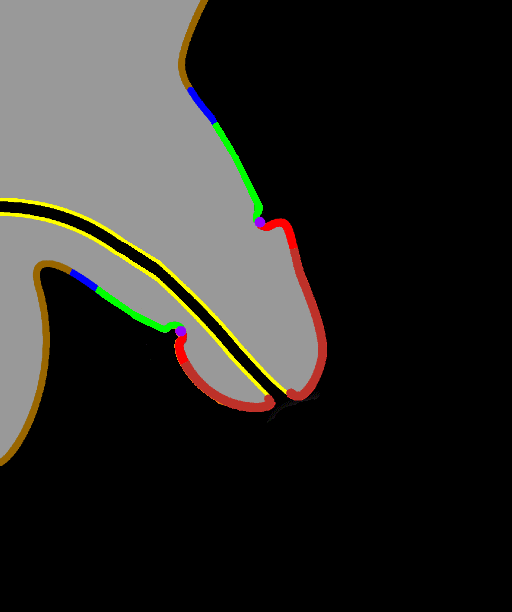 |
Much of the of inner foreskin has been retained, folded back on itself to face outwards and assume the role of shaft skin. The outer foreskin has been removed as has a considerable amount of shaft skin. This tightens the residual shaft skin so that the sulcus is fully exposed. In extreme cases a child's flaccid penis may appear to be shortened. |
 |
To enlarge these images, please use "View, Zoom" in your browser. |
The high/low debate in respect of sensitivity
One hotly debated issue in the world of circumcision is the question of the effect of style choice on sexual sensitivity. Proponents of the high style often assert that the exposed inner foreskin is for them a particularly erogenous zone, leading them to the conclusion that the high style is more sensitive than the low. Only men who have been recircumcised can have experienced both states and they are few in number. Thus the gathering of scientifically reliable data on this issue is difficult; too small a sample and only subjective, narrative reports to work with.
Some micro-anatomical investigations have been conducted to determine the precise distribution of nerve endings within the penis and it is clear that the nerve endings responsible for sexual sensation, termed Genital Corpuscles, are confined to the penile glans and shaft. (Halata and Munger, 1986; Halata and Spaethe, 1997, Cox et al, 2015.)
The loose/tight choice - can an a child be circumcised too tightly or too loosely?
In extreme cases excessive skin removal can cause the penis to retract into the body cavity. Even so, the skin will in due course stretch and full-size erections will normally be possible, and post-puberty the penis will outgrow the problem. Nevertheless the fact remains thet this is a botched circumcision, and very occasionally skin grafts are needed. The figure below shows how a tight circumcision
should be done.
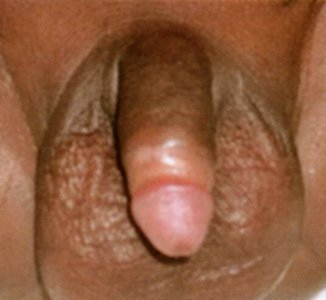 |
Left, a properly performed "tight" infant circumcision. There is no surplus mobile skin on the shaft but neither is the skin under tension. The coronal sulcus is completely exposed. As the boy grows up he will find that the skin is stretched tight with erections, but does not constrict them.
Below, three looser styles. All four circumcisions were done by different doctors using different techniques and all are examples of well-done circumcisions.
Photographs by D. Tomlinson, MD, from 'Surgical Guide to Circumcision' by Bolnick, Koyle and Yosha, with permission. |

A circumcision that is too loose may not leave the glans completely uncovered - it will, in other words, be a partial circumcision. This is not in itself a problem but it may not meet parental or religious expectations. However there is one important exception. If the scar can mobilise in front of the corona then it will always shrink and create a secondary phimosis. This requires recircumcision. If a partial circumcision is deliberately chosen then the best approach is the remove the inner foreskin completely, so that the scar is in the sulcus. At puberty the penis will usually outgrow the skin and leave the glans exposed.
Too high?
While many people favour retaining a lot of inner foreskin, this can sometimes cause problems. The inner skin is very thin and stretchable and if there happens to be a lot of post-operative swelling it can permanently stretch the skin, leaving it loose and puffy (right). This has no effect on penile function, but is can appear unsightly. | 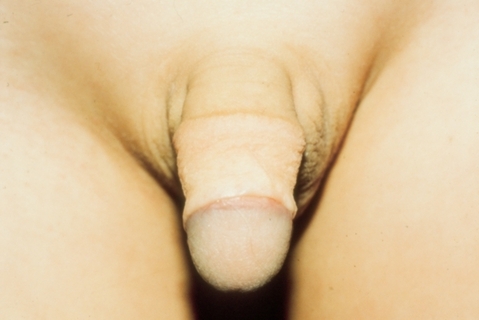 |
Frenulum removal
Irrespective of the choices made in respect of the high/low and loose/tight variables, the question arises of whether to remove or retain the frenulum, the web of tissue connecting the underneath of the glans to the inner foreskin.
This an extremely sensitive area, but the nerves are not in the frenulum, they reside in the glans below it. The sensitivity remains after removal of the frenulum. There are two caveats here. One is that a particularly thick or restrictive frenulum may prevent adequate stimulation. The other is that a thick scar from frenulum removal may have the same effect. When a 'low and tight' circumcision is done the remaining skin can be trimmed to a 'V' which will fit the space where the frenulum was. This gives smooth skin over the sensitive area and optimal sensitivity.
Note also that, when circumcision takes place in infancy, it is difficult to predict the outcome as regards the frenulum. In the newborn, it is not well developed. Even if it is retained, it may fail to develop further after circumcision.
For photographs of the different styles, go to the Illustrated Penile Anatomy page.
Copyright © 1992 - 2015, All Rights Reserved CIRCLIST.
















